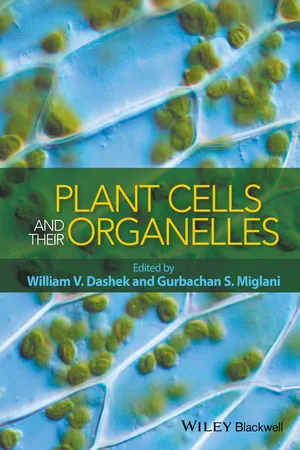Biological Sciences
Plant Cell Organelles
Plant cell organelles are specialized structures within plant cells that perform specific functions. These organelles include the nucleus, chloroplasts, mitochondria, endoplasmic reticulum, Golgi apparatus, vacuoles, and cell wall. Each organelle has a distinct role in processes such as photosynthesis, energy production, protein synthesis, and storage. The interactions and coordination of these organelles are essential for the overall functioning of the plant cell.
Written by Perlego with AI-assistance
Related key terms
5 Key excerpts on "Plant Cell Organelles"
- eBook - ePub
- Caroline Bowsher, Alyson Tobin(Authors)
- 2021(Publication Date)
- Garland Science(Publisher)
3 Plant Cell Structure Key Concepts The internal organization of plant cells is dependent on membranes. Membranes, which consist of lipids and proteins, depend on a water phase for their organization into two-dimensional sheets. Proteins are targeted to specific membranes and confer specific properties on the membrane, including its permeability to solutes. The plasma membrane defines the outer boundary of the cell, regulates solute exchange, and participates in cell wall formation. Vacuoles can occupy a very large proportion of cell space in vegetative tissues and store a variety of compounds, including pigments, proteins, and osmotically active solutes. The endomembrane system consists of two distinct compartments: the endoplasmic reticulum and the Golgi. It provides a complex internal space bounded by a membrane that is involved in the synthesis of proteins, polysaccharides, and lipids, mostly destined for export from the cell. Cell walls act as mechanical supports and osmoregulators and define the shape of each cell, ultimately defining the shape of the whole plant. Cell walls regulate the flux of molecules between cells and provide transport pathways within the plant. In common with other eukaryotic cells, most plant cells contain nuclei, which are concerned with the storage and expression of genetic information; mitochondria, which are mostly involved in respiration; and peroxisomes, which have diverse roles in plants. Plastids are a defining feature of plant cells and are specialized for a variety of functions, notably photosynthesis in all green tissues. Plant Organs and Tissues Consist of Communities of Cells The previous chapter (Chapter 2) emphasized the importance of plant cell structure in the biochemical functioning of the whole plant. It is the unique challenges plants face as sessile organisms that need to, for example, harvest solar energy, acquire inorganic mineral elements, cope with loss of water, etc., that determine their cell structure - eBook - ePub
- Martin J. Hodson, John A. Bryant(Authors)
- 2012(Publication Date)
- Wiley-Blackwell(Publisher)
Chapter 2 Introduction to Plant CellsThe previous chapter described the emergence in evolution of the angiosperms, the flowering plants. Much of the rest of this book deals with angiosperm function at the levels of organ and whole organism; we discuss the integration of growth and development, the angiosperm life cycle and the inter-organism interactions involved in various angiosperm lifestyles.However, in order to understand the plant as a functioning organism, it is necessary to have some knowledge of plant biology at the cellular and sub-cellular levels. Therefore, in this chapter and the next, we provide introductions to plant cells and to the major molecular activities in which the cells participate.2.1 Plant Cells
There is a sense in which there is no such thing as a ‘typical’ plant cell. Cell structure varies extensively according to the function of the cell in question. Nevertheless, it is helpful at this point to consider the main features of plant cells before looking at those features in more detail in subsequent sections. The features are illustrated diagrammatically in Figure 2.1 .Figure 2.1 Diagram of a plant cell.Author: Mariana Ruiz. http://en.wikipedia.org/wiki/File:Plant_cell_structure_svg.svgFirst, plant cells are characterized by being contained within a cell wall (section 2.2), composed mostly of polysaccharides and whose structure varies according to cell age and function. Inside the cell wall is the cell's outer membrane, the plasma membrane (section 2.3). In older cells, the next most obvious feature is the cell vacuole (section 2.8), a large aqueous space bounded by another membrane, the tonoplast. The vacuole's main functions are storage of particular solutes and the sequestration of hydrolytic enzymes. In vacuolated cells, the cytosol or cytoplasm is confined to a narrow zone between the vacuole and the plasma membrane (Figure 2.1 - eBook - ePub
- Laurie Ann Callihan(Author)
- 2013(Publication Date)
- Research & Education Association(Publisher)
Figure 3–9 , the organelles numbered 1 to 7 function the same way in plant cells as in animal cells (see above).1. Golgi apparatus2. Mitochondria3. Rough endoplasmic reticulum4. Ribosome5. Nucleus6. Nucleolus7. Smooth endoplasmic reticulum8. Cell walls surround plant cells. (Bacteria also have cell walls.) Cell walls are made up of cellulose and lignin, making them strong and rigid (whereas the cell membrane is relatively weak and flexible). The cell wall encloses the cell membrane, providing strength and protection for the cell. The cell wall allows plant cells to store water under relatively high concentration. The combined strength of a plant’s cell walls provides support for the whole organism. Dry wood and cork are essentially the cell walls of dead plants. The structure of the cell wall allows substances to pass through it readily, so transport in and out of the cell is still regulated by the cell membrane.9. The cell membrane (or plasma membrane) functions in plant and animal cells in the same way. However, in some plant tissues, channels connect the cytoplasm of adjacent cells.10. Chloroplasts are found in plant cells (and also in some protists). Chloroplasts are the site of photosynthesis within plant cells. Chlorophyll pigment molecules give the chloroplast their green color, although the chloroplasts also contain yellow and red carotenoid pigments. In the fall, as chloroplasts lose chlorophyll, these pigments are revealed, giving leaves their red and yellow colors. The body (or stroma ) of the chloroplast contains embedded stacked, disk-like plates (called grana ), which are the site of photosynthetic reactions.11. The central vacuole - eBook - ePub
- William V. Dashek, Gurbachan S. Miglani(Authors)
- 2016(Publication Date)
- Wiley(Publisher)
http://www.daviddarling.info/images/plant_cell.jpg and http://micromagnet.fsu.edu . The organelle contents of plant and animal cells in common and those unique to plant cells are depicted in Table 1.4 . The dimensions of plant organelles are presented in Table 1.5 . A plant organelle database (PODB) has been reviewed by Mano et al. (2008).Comparison of organelle contents of plant and animal cells.*Table 1.4Organelle Animal cell Plant cell Cell wall Absent Present Centrioles Present Absent Endoplasmic reticulum Present Present Glyoxysomes Absent Present Golgi apparatus Present Present Microfilaments Present Present Mitochondrion Present Present Nucleus Present Present Peroxisomes Present Present Plastids Absent Present Protein bodies Absent Present Spindle Present Present Vacuoles Sometimes small Present (mature cell – large central) * Early discussions of Plant Cell Organelles occur in Hongladarom et al. (1964), Pridham (1968), Reid and Leech (1980) and Tobin (1992).Dimensions of subcellular organelles.Table 1.5Organelles Dimension Chloroplast 4–6 µm in diameter Golgi apparatus Individual cisternae, 0.9 µm Coated vesicles 50–280 µm in diameter Microbodies 0.1–2.0 µm in diameter Microtubules 0.5–1.0 µm in diameter Mitochondria 1–10 µm Nuclear envelope pores 30–100 µm in diameter Nucleus 5–10 µm in diameter Peroxisome 0.2–0.7 µm Plasmodesmata 2–40 µm in diameter Primary wall 1–3 µm Protein bodies 2–5 µm in diameter Vacuoles 30–90% of cell volume To enter a plant cell, molecules must traverse both the cell wall and the fluid mosaic plasmalemma (Singer and Nicolson, 1972; Leshem et al., 1991; Larsson and Miller, 1990). In contrast to the fluid mosaic model (Figure 1.8 ) of the plasmalemma, the picket–fence model proposes the accumulation of membrane protein anchored in an actin network beneath the membrane (Kusumi et al., 2012).Figure 1.8 - eBook - ePub
- Patricia Barnes-Svarney, Thomas E. Svarney(Authors)
- 2014(Publication Date)
- Visible Ink Press(Publisher)
PLANT STRUCTURE, FUNCTION, AND USE
PLANT STRUCTURES
How are plants defined?
Plants are defined in many ways due to their great number. In general, a plant is a multicellular, eukaryotic organism with cellulose-rich cell walls and chloroplasts that has starch as its primary carbohydrate food reserve. Most are photosynthetic and are primarily terrestrial, autotrophic (capable of making their own food) organisms.What are the major characteristics of vascular (tracheophyte) plants?
The majority of vascular plants consist of roots, shoots, and leaves. The root system penetrates the soil below ground and anchors the plant; there, the roots absorb water and various materials necessary for plant nutrition. The shoot system consists of the stem and the leaves and is the part of the plant above ground level. The stem provides the framework for the positioning of the leaves; the leaves are the sites of photosynthesis. Growing plants maintain a balance between the size of the root system and the shoot system. The total water- and mineral-absorbing surface area in young seedlings usually far exceeds the photosynthesizing surface area. As a plant ages, the root-to-shoot ratio decreases. Additionally, if the root system is damaged, shoot growth is reduced by lack of water, minerals, and root-produced hormones.What are some specialized cells in vascular plants?
All plant cells have several common features, such as chloroplasts, a cell wall, and a large vacuole. In addition, a number of specialized cells are found only in vascular plants. The following lists the main plant cells (for more information about cells, see the chapter “Cellular Basics ”)—also called ground tissue (that functions mainly in support, storage, and photosynthesis):Parenchyma cells —Parenchyma (from the Greek para , meaning “beside,” and en + chein
Learn about this page
Index pages curate the most relevant extracts from our library of academic textbooks. They’ve been created using an in-house natural language model (NLM), each adding context and meaning to key research topics.




